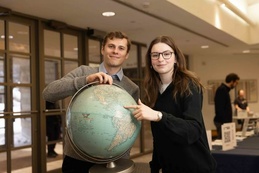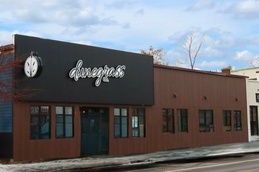
Build Your Own Classic Snowshoes
Make Tracks
By Kristi Kates | Jan. 20, 2018
Of all the things made in Michigan, the things you can make yourself are often some of the best. And if you love our great outdoors in the winter, there is no better DIY than building a set of Michigan’s oldest shoes for yourself.
Craig Kasmer is a naturalist and park interpreter at Hartwick Pines State Park in Grayling, where teaching visitors how to craft their own snowshoes has been a popular workshop for years.
“I’ve been here at Hartwick Pines for 16 years, and teaching the snowshoe workshops for 12,” said Kasmer. “I learned how to make snowshoes from one of my colleagues, Alan Wernette, who’s now at Ludington State Park. And now we have people coming from downstate, Ohio, even as far away as Texas, to take the workshops.”
Kasmer collaborates with Hillary Pine, the historian at the park, to teach classes of 10 people each how to make the snowshoes. Perhaps surprisingly, there are more types of snowshoes than you might think.
SNOWSHOE MADNESS
“There are several different types of snowshoes, anything from traditional Michigan or ‘Huron’ style — rounded at the top and pointed at the bottom, to Alaskan, which also have rounded tops and pointed bottoms but are a lot longer, like five feet.”
Ojibway snowshoes are pointed at both the top and tail; the “bearpaw” — the kind of snowshoe you see displayed at ski lodges — are almost completely round.
“You almost have to waddle when you wear those,” Kasmer said. “The modified bear paw is better. It’s still oval, but more narrow so it’s easier to walk in.”
It’s definitely not a style thing with snowshoes, either. It’s different mobility for different conditions.
“For instance, the Ojibway carry a lot of gear, and often walk through big open fields, which means big snowdrifts. Their snowshoes are longer to displace more weight, and the point in front means you can poke your way through snowdrifts. Alaskan snowshoes are even bigger, to displace as much snow as possible.”
More rounded snowshoes have their own advantages. They’re usually smaller, so if you’re in a forested area with lots of little saplings and undergrowth, it’s easier to step over and around things.
“There’s a method to the madness of all the different kinds of snow shoes,” Kasmer said.
THE FUN PART
Snow affects how the snowshoes work, although maybe in the opposite way that you might expect. Lighter snow, Kasmer said, means you’ll stay more on top of it, while heavier, “snowball-making” snow compacts, causing walkers to sink.
“You actually do sink some with every snowshoe, but the size and shape of it determine just how much,” Kasmer explained.
Kasmer and Pine instructed classes how to make modified bear paw snowshoes this past November, December, and January. In the upcoming February and March workshops, they’ll teach students how to build Ojibway snowshoes.
Each workshops begin with an introduction to snowshoes. Kasmer and Pine also chat with the workshops’ participants, to find out if they plan to actually use the snowshoes or just display them.
“We also like to hear what other hobbies people have,” Kasmer said. “Experience in basketweaving, knitting, or crocheting often helps people make the snowshoes.”
The making, he added, “is the fun part.”
“A lot of people are nervous about it — it seems daunting to them,” he said. “And when you’re new to the process, it can be slow, and learning is tricky. So we break it down into segments, with diagrams to help, and Hillary and I walk around the room to help step everyone through it. That’s why we’re here.”
KEEP ON GOING
Participants will use a 45-foot-long lace to make the footbed of their snowshoes, weaving the lace into the frame. For the bear paw style, the snowshoe is 10 inches wide and 36 inches long; for the Ojibway, it’s 11 inches wide and 54 inches long.
Each two-day workshop (Saturday and Sunday) starts at 9am, and includes a lunch break (bring your own bagged lunch), but Kasmer said many people just keep right on going.
“People find it really rewarding to make the snowshoes,” he said. “It’s a real accomplishment. I see people texting their friends to show them, putting it all over Facebook. And we get to help, which is rewarding for us. Our job is to pull people back from the edge of ‘I can’t do this!’ Being patient and helpful gives them the confidence to complete their snowshoes.”
“Afterward, people often come back to Hartwick Pines, and say, ‘Hey Craig! remember us? We’re going snowshoeing today on the snowshoes we made!’”
Each two-day snowshoe-making workshop class, held in the Michigan Forest Visitor Center at Hartwick Pines, costs $185, including the materials you need to make a pair of snowshoes (frame, binding, precut laces.) Park entry fees may also apply.
The next round of workshop dates (fall/winter 2018–2019) will be announced this summer. Even though snowshoes may be the farthest thing from your mind in July or August, Kasmer encourages those interested to sign up as early as possible for next year, as each class allows only 10 people. There’s a lot of interest, and limited space.
“They definitely fill up fast!” he added.
For more information, visit michigan.gov/hartwickpines or call (989) 348-2537. Hartwick Pines State Park is located at 4216 Ranger Rd. in Grayling.
Trending

Michigan’s Marijuana Tax at Work
Cannabis has become a big business in northern Michigan, and local governments are putting tax dollars earned from dispensar… Read More >>
California Sober: Why People Are Switching from Alcohol to Weed
They call it “California sober.” Generally speaking, this term applies to folks who use marijuana but abstain f… Read More >>
The Legacy of Student Activism
“It’s a physical letter to your representative,” Alex Tank says when asked to define the word “prote… Read More >>


